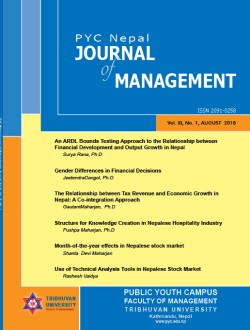The Relationship between Tax Revenue and Economic Growth in Nepal: A Co-integration Approach
DOI:
https://doi.org/10.3126/pycnjm.v11i1.35916Keywords:
GDP, Tax revenue, Non-tax revenue, ADF test, Enger-Granger Co-integration testAbstract
The main objective of this paper is to examine the relationship between tax revenue and economic growth in Nepal. The 43 years' annual time series data from 1974/75 to 2016/17 of GDP, tax revenue and nontax revenue have been used to test the causal relationship of the variables. A unit root test, Engle-Granger’s co-integration and Error Correction Model have been applied for the data analysis. The variables have been found stationary after first differencing I(1) when Augmented Dickey-Fuller unit root test is employed. From Engel-Granger test, it has been found that the variables are co-integrated. The short-term coefficients are not significant, however error correction term (ECT) is significant and contains a negative sign in the error correction model (ECM). It validates the ECM model. The ECT has shown that the annual speed of adjustment from disequilibrium to equilibrium is 34.3 percent. So far as the relationship is concerned, there is a long run relationship between tax revenue and economic growth in Nepal controlling the non-tax revenue. The impact of tax revenue on economic growth could be a good impetus for the policy maker and planner to increase the collection of revenue for the country.
Downloads
Downloads
Published
How to Cite
Issue
Section
License
© Public Youth Campus

